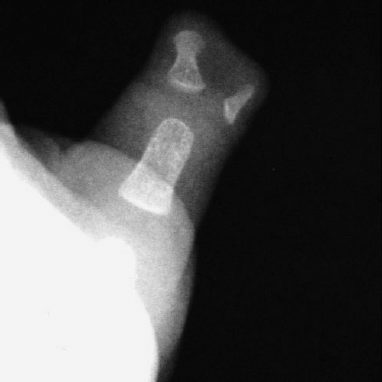82
Polydactyly and Bifid Thumb
Kevin D. Plancher
History and Clinical Presentation
A 2-year-old girl presents for evaluation of her duplicate thumb. The family recently moved from the Dominican Republic. The mother reports that her uncle had the same condition.
Physical Examination
The patient has an obvious deformity of the thumb (Fig. 82–1). The forearm and hand are one half the width of the other arm. There is no other malformation on the child’s hands or feet. The patient was referred for a complete genetic workup. The hand itself is fully functional.
Diagnostic Studies
Radiographs show a single but widened metacarpal with a bifid proximal phalanx (Fig. 82–2). Hematologic indices, including complete blood count with differential, platelet count along with prothrombin time (PT), and partial thromboplastin time (PTT), were checked preoperatively to rule out thrombocytopenia or any coagulopathy.

Figure 82–1 The patient’s widened thumb.

Figure 82–2 Radiographs show a single but widened metacarpal with a bifid proximal phalanx.
PEARLS
- For symmetrical thumb duplication, a Bilhaut-Cloquet (Fig. 82–3) technique is preferred; however, technical expertise is needed.
- Initial dissection should expose and retain all tissues until the anatomic orientation is exposed.
- After final determination is made to remove the more hypoplastic thumb, then safely ligate the neurovascular structures.
PITFALLS
- Ignoring a zigzag deformity can lead to additional complications.
- Recurrence of the deformity can be seen in reconstructions done prior to 18 months of age.
- Incomplete correction and instability at the reconstructed metacarpophalangeal joint

Figure 82–3 Distal phalanx with artwork showing the technique for a Bilhaut-Cloquet.
Differential Diagnosis
Duplicated thumb (classification system Table 82–1)
Diagnosis
Bifid Proximal Phalanx of the Thumb
Stay updated, free articles. Join our Telegram channel

Full access? Get Clinical Tree








